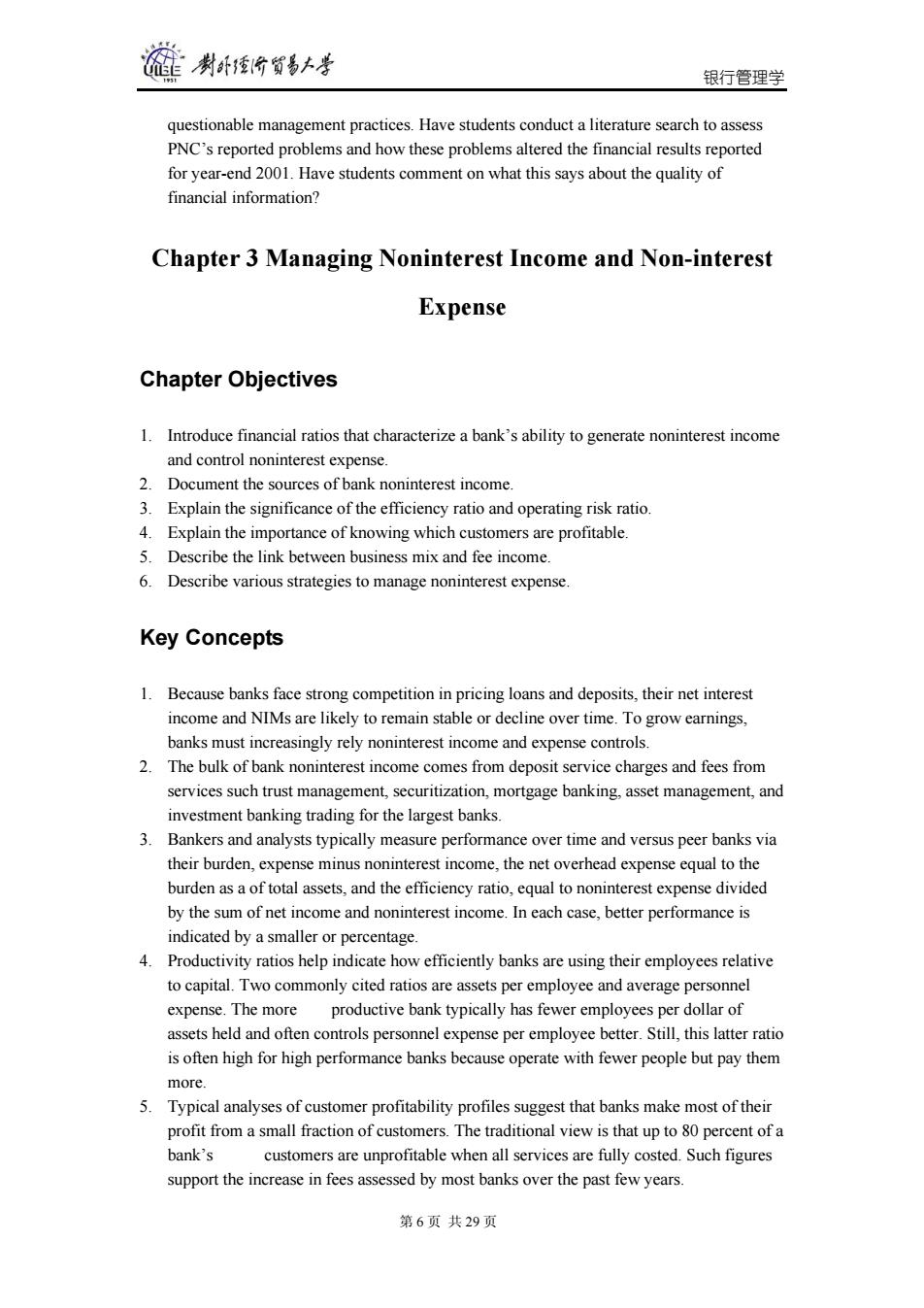正在加载图片...

制卧台贸易上考 银行管理学 questionable management practices.Have students conduct a literature search to assess PNC's reported problems and how these problems altered the financial results reported for year-end 2001.Have students comment on what this says about the quality of financial information? Chapter 3 Managing Noninterest Income and Non-interest Expense Chapter Objectives 1.Introduce financial ratios that characterize a bank's ability to generate noninterest income and control noninterest expense 2.Document the sources of bank noninterest income. 3.Explain the significance of the efficiency ratio and operating risk ratio 4.Explain the importance of knowing which customers are profitable. 5.Describe the link between business mix and fee income. 6. Describe various strategies to manage noninterest expense. Key Concepts 1.Because banks face strong competition in pricing loans and deposits,their net interest income and NIMs are likely to remain stable or decline over time.To grow earnings, banks must increasingly rely noninterest income and expense controls. 2.The bulk of bank noninterest income comes from deposit service charges and fees from services such trust management,securitization,mortgage banking,asset management,and investment banking trading for the largest banks. 3.Bankers and analysts typically measure performance over time and versus peer banks via their burden,expense minus noninterest income,the net overhead expense equal to the burden as a of total assets,and the efficiency ratio,equal to noninterest expense divided by the sum of net income and noninterest income.In each case,better performance is indicated by a smaller or percentage. 4.Productivity ratios help indicate how efficiently banks are using their employees relative to capital.Two commonly cited ratios are assets per employee and average personnel expense.The more productive bank typically has fewer employees per dollar of assets held and often controls personnel expense per employee better.Still,this latter ratio is often high for high performance banks because operate with fewer people but pay them more. 5.Typical analyses of customer profitability profiles suggest that banks make most of their profit from a small fraction of customers.The traditional view is that up to 80 percent of a bank's customers are unprofitable when all services are fully costed.Such figures support the increase in fees assessed by most banks over the past few years. 第6页共29页银行管理学 第 6 页 共 29 页 questionable management practices. Have students conduct a literature search to assess PNC’s reported problems and how these problems altered the financial results reported for year-end 2001. Have students comment on what this says about the quality of financial information? Chapter 3 Managing Noninterest Income and Non-interest Expense Chapter Objectives 1. Introduce financial ratios that characterize a bank’s ability to generate noninterest income and control noninterest expense. 2. Document the sources of bank noninterest income. 3. Explain the significance of the efficiency ratio and operating risk ratio. 4. Explain the importance of knowing which customers are profitable. 5. Describe the link between business mix and fee income. 6. Describe various strategies to manage noninterest expense. Key Concepts 1. Because banks face strong competition in pricing loans and deposits, their net interest income and NIMs are likely to remain stable or decline over time. To grow earnings, banks must increasingly rely noninterest income and expense controls. 2. The bulk of bank noninterest income comes from deposit service charges and fees from services such trust management, securitization, mortgage banking, asset management, and investment banking trading for the largest banks. 3. Bankers and analysts typically measure performance over time and versus peer banks via their burden, expense minus noninterest income, the net overhead expense equal to the burden as a of total assets, and the efficiency ratio, equal to noninterest expense divided by the sum of net income and noninterest income. In each case, better performance is indicated by a smaller or percentage. 4. Productivity ratios help indicate how efficiently banks are using their employees relative to capital. Two commonly cited ratios are assets per employee and average personnel expense. The more productive bank typically has fewer employees per dollar of assets held and often controls personnel expense per employee better. Still, this latter ratio is often high for high performance banks because operate with fewer people but pay them more. 5. Typical analyses of customer profitability profiles suggest that banks make most of their profit from a small fraction of customers. The traditional view is that up to 80 percent of a bank’s customers are unprofitable when all services are fully costed. Such figures support the increase in fees assessed by most banks over the past few years